#Han dynasty
Explore tagged Tumblr posts
Text

mumei consults the I Ching
#mumei nanashi#hololive#i ching#han dynasty#fiddlesticks#get it she's fiddling with sticks (yarrow stalks) I AINT WASHED YET#def not what it looked like back then... i could only do 20 mins of research before bed#comic#wlart#williamleonard
2K notes
·
View notes
Text
Different brow shapes in historic China. Which one do you like most?
(My favourite is the Moon curved brows and the Moth brows, although the Osmanthus leaf brow is what I picture when I think of the Tang Dynasty.)
Src:
杨子古典美学妆造
【来看看古代都有什么眉形?】
https://www.bilibili.com/video/BV1QCCJY4E2U/
(ENG subs by me :D)
#hanfu#汉服#china#中国#chinese hanfu#culture#history#古代眉毛#唐朝#宋朝#汉代#Eyebrows#Chinese historic eyebrows#tang dynasty#song dynasty#han dynasty#makeup#Historic makeup
664 notes
·
View notes
Text
i love the hilarious eunuch ranking system by @welcometothejianghu so i decided to make one based on (mostly) REAL historical chinese enunchs!
in chronological order:
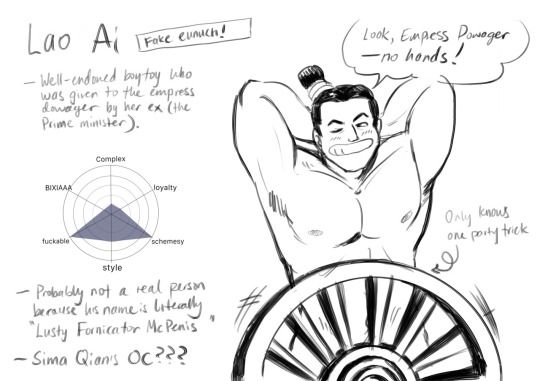
Warring States Period long story short, the PM is sleeping with the Empress Dowager, and he wants to extracate himself before her son (future Emperor Qin Shi Huang) gets old enough to find out. the PM finds her a suitable replacement, and the replacement is attached to a guy named Lao Ai. They pluck his beard and pass him off as a eunuch so he can sneak into the palace. Bing bang boom everyone's happy. This goes terribly wrong later, since Lao Ai tries to replace the emperor with his own kids and stages a failed coup. rest in pieces buddy...
it's very likely that Lao Ai was a ficticious character invented by Sima Qian, who will be appearing on this list later.
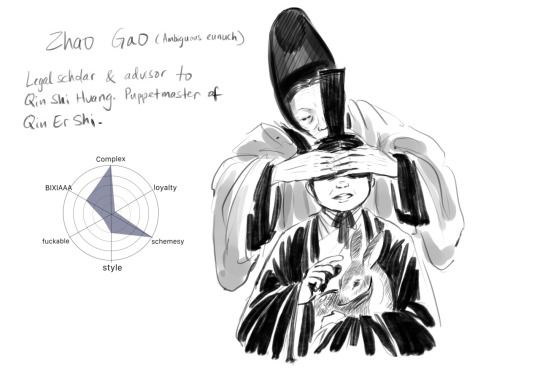
Qin Dynasty
Zhao Gao helped the first emperor of China conquer an empire, and administer it efficiently with his legal knowledge, but he also made the second emperor into a puppet, and weakened the empire for his own political gain. Max points of complexity, but you'd get more loyalty out of a coffee club punch card.
Before launching his soft coup, he decided to test the waters by bring in a deer and gaslighted the emperor by calling it a horse. the officials who were loyal to him called it a horse, and he executed the rest.

Han Dynasty Jiru, male favourite of Emperor Gaozu (Liu Bang), the peasant scoundrel who became the founder of the Han Dynasty. look, if the emperor has a harem of hundreds of women and you manage to catch his attention, you max out in style points. simple as. for most of chinese history it was fairly common for high-ranking men, especially eunuchs, to wear make up like powder and rouge, but i decided to give Jiru some women's huadia as well, cause he's a baddie.
Jiru gets a bad rap for alledgely distracting the emperor from his duties, but lets be real, history is written by civil officials who have no shortage of professional jealousy and gender/sexuality related prejudice towards eunuchs, since they were the personal attendants of royalty and could exert a lot of influence. plus Liu Bang was already pissing in the hats of confucian scholars, most of the poor work ethic is on HIM. Jiru should get credit for making him marginally less of a troglodite.
all in all he didn't try any court intrigue so extra points for loyalty and complexity. free my man >:( he's just a Han dynasty Monica Lewinsky who got slutshamed by jealous coworkers >:(
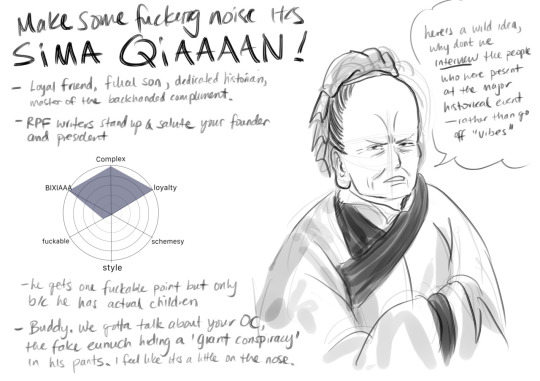
Han Dynasty
meet the father of east asian history, sima qian. half the people on this list can owe their placement here thanks to his extremely though history books "records of the grand historian"
history at this time was mostly "creative writing" and sima qian attempted to give the practise more academic intergrety, he went out and personally interviewed people, tried to get primary sources, and got rid of most of the more fanstastical aspects. however, he was not without his biases and some texts can be seen as allegorical/veiled insults towards the Han Dynasty, especially towards Emperor Wu. unlike most of the people on this list, sima qian was from the gentry and castated later in life as a punishment for treason. he was implicated after trying to defend a friend, and could not pay the fine to commute his sentence. the gentlemen at the time were expected to die by suicide rather than live with such ignimony, but sima qian chose to live so he could finish writing the history book his father started. the "giant conspiracy" joke explained: the chinese word for penis is a homophone for "conspiracy".
720 notes
·
View notes
Text
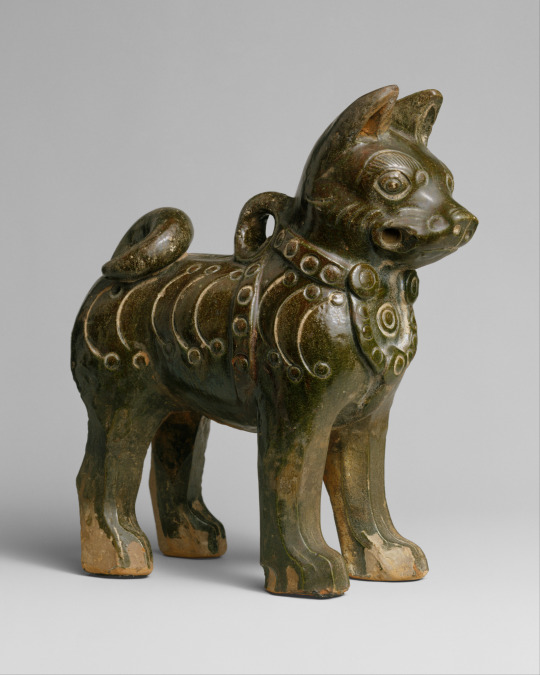
Earthenware figurine of a dog, China, Eastern Han Dynasty 25-220 AD
from The Metropolitan Museum of Art
3K notes
·
View notes
Text

Notification: Oh, there is a widow in Qing Jing Peak...+150 Protagonist's coolness points...?
Now, for the fashion stuff:
This is SQQ during the 3 years of the abyss arc! Empress Shen will be coming soon, I promise.
White was the mourning color in ancient China, and I thought it would be cool if SQQ takes to wearing lighter colors during Binghe's supossed "death" (He probably doesn't even notice he's doing it tbh)
Binghe was the one putting his hair up, so now he's helplessly doing low ponytails and putting on minimal jewelry bc he doesn't know how to put all the hair accessories on.
His hair is longer now! Some years passed, and he's not trimming it at all, people just think he's being extra filial and stuff. Acquiring good Karma for Binghe, maybe?
He tells everyone he is not crying or mourning, but the permanent crying face does not help his case at all man.
These are still Han dynasty robes! Though the tighter style of it.
LQQ and YQY are desperately buying him trinkets and pretty fans and stuff to see if his mood goes up (it does not), everyone else thinks they're competing for second husband
Luo Binghe almost actually dies when he sees SQQ for the first time dressed like this in Jin Lan City. It gets worse when he learns it's because of him.
#artists on tumblr#digital art#art#my art#fanart#svsss#scum villain#scum villain fanart#scum villian self saving system#scum system#shen qingqiu#shen yuan#peerless cucumber#cucumber bro#bingqiu#han dynasty#chinese hanfu#hanfu#hanfu fashion#hanfu accessories#chinese fashion
933 notes
·
View notes
Text
April 13, Xi'an, China, Shaanxi Archaeology Museum/陕西考古博物馆 (Part 3 - Qin dynasty to Sui dynasty):
First up is one of many bronze edict tablets of the 2nd emperor of Qin dynasty, made in 209 BC. Inscribed upon it in Seal script is one of two edicts, specifically the one from the 2nd emperor of Qin dynasty (秦二世), which basically is a continuation of Qin Shi Huang's edict on standardizing all weights and measurements. Here Qin Shi Huang/秦始皇 is referred to as Shi Huangdi/始皇帝, where shi/始 means "origin", and huangdi/皇帝 means "emperor".

^The edict inscribed is as follows (this is my VERY rough translation, please take this with a grain of salt, I'm not great at reading Old Chinese; original text is on bottom right of picture):
“First year (209 BC; first year of 2nd Emperor of Qin's reign), [We] issued an edict to chancellors Li Si and Feng Quji: Shi Huangdi pioneered this effort to standardize all weights and measurements, since then all such edicts have been inscribed on bronze. Now that [We have] inherited this Huangdi title, [We] shall not refer to Ourselves as Shi Huangdi here. Likewise, should Our descendants continue to produce tablets of Shi Huangdi's edict, they shall not take credit for Shi Huangdi's achievements. [We] hereby inscribe this edict on the left, so that all may be clear."
Ever since Qin Shi Huang tried to standardize systems of measurements for the entire country, every dynasty since Qin dynasty has also done the same. These are the standardized weights and volume measurements (all made with bronze) from Western Han dynasty (202 - 8 BC). Those volume measurement tools are very much like oversized measurement spoons, since they are mostly used to measure liquids and grains (in ancient China grains can be measured by volume).

Looks like I forgot about this one in part 2, this is a bronze sword from Warring States period (475 - 221 BC), I believe. It's decorated with carved pieces of jade (some are on the scabbard, but the scabbard has presumably decomposed over time):

The painted and carved stone doorway to a Eastern Han dynasty (25 - 220 AD) tomb. The actual (double) doors are in the middle, and the pieces around them are the side jambs and the lintel. Note the animals, mythical creatures, and humans depicted. On the double doors, in order from top to bottom, there's a pair of Zhuque/朱雀/Vermilion Bird, a pair of symbolic door knockers shaped like a beast carrying a ring in its mouth, and a pair of oxen. On the top right and top left of the lintel piece, you can also clearly see the sun crow and the moon toad, respectively.

The layout of some Western Han dynasty (202 - 8 BC) mausoleums. Note that the "pyramids" on the model aren't stone pyramids like the Great Pyramid of Giza, they are actually fengtu/封土, or artificial mounds of earth on top of the actual tomb to symbolically seal the tomb (feng/封 means "seal" or "to seal"), and can serve as tomb markers. Fengtu can differ vastly in size according to the social status of the deceased, so the fengtu of imperial tombs are usually huge, some so big that they are like small hills. However, while Western Han dynasty imperial tombs have these square-ish fengtu mounds, in Eastern Han dynasty (25 - 220 AD) the fengtu mounds became circular, and imperial tomb fengtu have been circular pretty much ever since. But fengtu wasn't just reserved for the elites, common folk also built small circular fengtu mounds on top of graves (these graves are called fen/坟; graves without fengtu are called mu/墓), and this is still practiced today, albeit much more common in rural areas since there are less people and more land. When people tend to the graves of their family members and ancestors on Qingming Festival, if the grave is a fen grave, people would pile more earth on the fengtu to make it rounder as part of the upkeep process.

A set of pottery figurines of entertainers from a Western Han era tomb. I love how they set the display up here, you can practically imagine the music and the dancing

More pottery figurines from Western Han era tombs

Western Han era hollow clay bricks depicting the Four Symbols/四象 of the cardinal directions: Qinglong/青龙/Azure Dragon of the East, Zhuque/朱雀/Vermilion Bird of the South, Xuanwu/玄武/Black Tortoise of the North, and Baihu/白虎/White Tiger of the West.

Left: a piece of intricately painted lacquered wood, I forgot where it's from but it was probably a piece of decoration on a larger artifact. Right: a piece of gold decoration inlaid with turquoise from Western Han era


The biggest decorated yubi/玉璧 (jade disc with hole in the middle) found so far, from an early Western Han dynasty tomb. Its diameter is 43.2 cm (~17 inches). If you zoom in, the inner band is decorated with these almost tadpole-like little swirls, and these are called gu pattern/谷纹, since they might represent sprouting rice kernels. The outer band is decorated with 4 sets of kuilong patterns/夔龙纹 and 4 sets of dragon-phoenix patterns/龙凤纹. It's speculated that the patterns here together depict the universe, and the hole in the middle is where the spirit of the deceased will travel through. This particular yubi also has 六百六十一 ("six hundred and sixty-one") carved discreetly on the side, presumably a "serial number" left by the artisan who crafted this piece.

Decorated backs of bronze mirrors. I didn't take a picture of the plaque so I'm unclear on what time period these are from (may or may not be from the time period indicated at the beginning of the post):

Left: a hand-held incense burner. Right: a particular type of incense burner called a boshanlu/博山炉, so named because the lid was made to look like a mini mountain


Various Northern Zhou dynasty (557 - 581 AD) painted pottery figurines. Below middle arranged in a circle is the metal pieces on a belt.

Sixteen Kingoms era pottery entertainer figurines:

#2024 china#xi'an#china#shaanxi archaeology museum#chinese history#chinese culture#qin dynasty#han dynasty#northern zhou dynasty#sixteen kingdoms period#archaeology#history#culture
222 notes
·
View notes
Text




Wearing Hanfu robes at a museum
From Hanfu Photographer-Shan Lan
94 notes
·
View notes
Text
[Hanfu · 漢服]The relationship between women in history is not just love rivals,
“but also thousands of years later, everyone knows that it is me and you.”
Let's get to know about them/她们 in China history.
1.【Han Dynasty】:Princess Jieyou (解忧公主) & Feng Liao (馮嫽)
Princess Jieyou (Chinese: 解忧公主; 121 BC – 49 BC), born Liu Jieyou (Chinese: 刘解忧), was a Chinese princess sent to marry the leader of the Wusun kingdom as part of the Western Han Chinese policy of heqin(和亲).
As the granddaughter of the disgraced Prince Liu Wu (劉戊) who had taken part in the disastrous Rebellion of the Seven States,her status was low enough that she was sent to replace Princess Liu Xijun (劉細君) after her untimely death and marry the Wusun king Cunzhou (岑陬).
Jieyou lived among the Wusun for fifty years and did much work to foster relations between the surrounding kingdoms and the Han. She was particularly reliant upon her attendant, Feng Liao, whom she dispatched as an emissary to Wusun kingdoms and even to the Han Court. She faced opposition from pro-Xiongnu members of the Wusun royalty, particularly Wengguimi’s Xiongnu wife. When word came that the Xiongnu planned to attack Wusun, she convinced her husband to send for aid from the Han Emperor. Emperor Wu of Han sent 150,000 cavalrymen to support the Wusun forces and drive back the Xiongnu.
In 51 BCE at the age of 70, Jieyou asked to be allowed to retire and return to the Han. Emperor Xuan of Han agreed and had her escorted back to Chang'an where she was welcomed with honor. She was given a grand palace with servants usually reserved for princesses of the imperial family. In 49 BCE, Jieyou died peacefully.
Feng Liao (馮嫽)
Feng Liao (馮嫽) was China's first official female diplomat,[citation needed] who represented the Han dynasty to Wusun (烏孫), which was in the Western Regions. It was a practice for the Imperial Court to foster alliances with the northern tribes via marriage, and two Han princesses had married Wusun kings.
Feng Liao was the maidservant of Princess Jieyou (解憂公主), who was married off to a Wusun king. Feng herself later married an influential Wusun general, whose good standing with Prince Wujiutu (烏就屠) of the kingdom later proved beneficial to the Han dynasty.
When Prince Wujiutu seized the throne of Wusun in 64 BC, after his father died, there was fear in the Imperial Court of Han that Wujiutu, whose mother was Xiongnu, would allow Wusun to become Xiongnu's vassal.
Zheng Ji, Governor of the Western Regions, recalled that Feng Liao had married into Wusun and with her familiarity of the Wusun customs, she was a prime candidate to persuade Wujiutu to ally his kingdom with Han. Wujiutu acceded and Emperor Xuan of Han (漢宣帝) sent for Feng. He praised her for her judgement and diplomacy, and appointed her as the official envoy to Wusun.
Wujiutu was conferred the title "Little King of Wusun" while his brother, the son by a Han princess, was named "Great King of Wusun". Wusun was divided between the two kings and tensions in that region were eased.
※Xiongnu: Xiongnu: A nomadic tribe that has occupied northern China for a long time. Later it gradually became a state. It harassed the borders of the Han Dynasty for a long time and robbed supplies.
------
With their efforts, the Wusun Kingdom gradually tended to support the Han Dynasty, and the Xiongnu's defeat in China also began.
------
2.【Tang Dynasty】:Shangguan Wan'er(上官婉儿)&Princess Taiping (太平公主)
Shangguan Wan'er/上官婉儿 (664 – 21 July 710) was a Chinese politician, poet, and imperial consort of the Wu Zhou and Tang dynasties. Described as a "female prime minister,"Shangguan rose from modest origins as a palace servant to become secretary and leading advisor to Empress Wu Zetian of Zhou. Under Empress Wu, Shangguan exercised responsibility for drafting imperial edicts and earned approbation for her writing style. She retained her influence as consort to Wu's son and successor, Emperor Zhongzong of Tang, holding the imperial consort rank of Zhaorong (昭容). Shangguan was also highly esteemed for her talent as a poet.Shangguan was also highly esteemed for her talent as a poet. In 710, after Emperor Zhongzong's death, Shangguan was killed during a palace coup that ended the regency of Empress Dowager Wei.
Princess Taiping (太平公主)lit. "Princess of Great Peace", personal name unknown, possibly Li Lingyue (李令月) (after 662 – 2 August 713) was a royal princess and prominent political figure of the Tang dynasty and her mother Wu Zetian's Zhou dynasty. She was the youngest daughter of Wu Zetian and Emperor Gaozong and was influential during the reigns of her mother and her elder brothers Emperor Zhongzong and Emperor Ruizong (both of whom reigned twice), particularly during Emperor Ruizong's second reign, when for three years until her death, she was the real power behind the throne.
She is the most famous and influential princess of the Tang dynasty and possibly in the whole history of China thanks to her power, ability and ambition. She was involved in political difficulties and developments during the reigns of her mother and brothers. Indeed, after the coup against Empress Dowager Wei, she became the real ruler of Tang. During the reign of Emperor Ruizong, she was not restricted by anything, the emperor issued rulings based on her views and the courtiers and the military flattered her and majority from every civil and military class joined her faction, so her power exceeded that of the emperor.
Eventually, however, a rivalry developed between her and her nephew, Emperor Ruizong's son, Crown Prince Li Longji. Both of them were hostile in power-sharing and they fought for the monopoly over power. After Emperor Ruizong yielded the throne to Li Longji (as Emperor Xuanzong) in 712, the conflict came to the political forefront, and openly, the court became a manifestation of conspiracy rather than the administration of the empire; in 713, Emperor Xuanzong, according to historical records, believing that she was planning to overthrow him, acted first, executing a large number of her powerful allies and forcing her to commit suicide.
------
The relationship between Shangguan Wan'er and Princess Taiping has always been written as "enemies" in official history, but with the phrase "千年万岁,椒花颂声", their friendship that has been buried for thousands of years was revealed.
The"千年万岁,椒花颂声" sentence comes from the epitaph written by Princess Taiping for Shangguan Wan'er. The original text is: "潇湘水断,宛委山倾,珠沉圆折,玉碎连城。甫瞻松槚,静听坟茔,千年万岁,椒花颂声”
Translation: Now that you are far away, the sky and the earth will lose their color. I'm afraid that all I can do in the future is to sit and look at the tea tree in front of your tomb. Maybe I can hear your voice again when I stand within an inch of the tomb. But this is a delusion after all, a quiet tomb, no beautiful face, a empty place of death. I hope that in a thousand or ten thousand years, there will still be people like me who remember you.
------
3.【Late Qing Dynasty】:Lü Bicheng(呂碧城) & Qiu Jin (秋瑾)
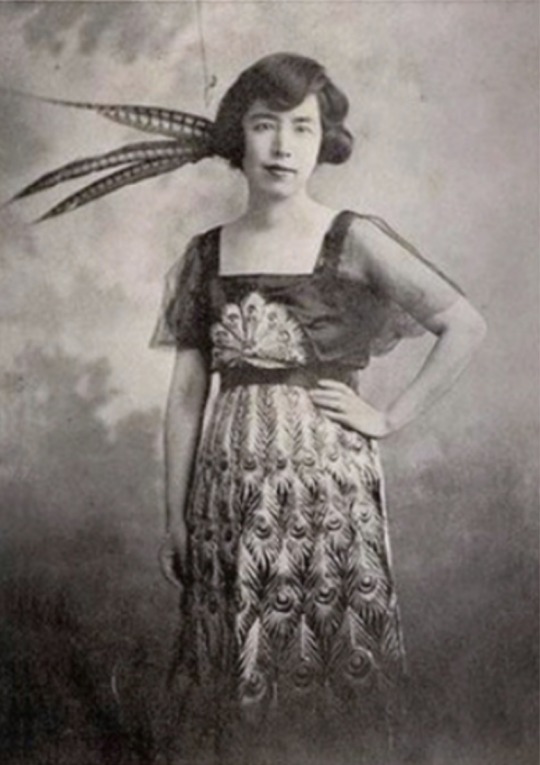
Lü Bicheng(呂碧城)also known as Alice Pichen Lee(1883–1943) was a Chinese writer, activist, newspaper editor, poet and school founder. She has been mentioned as one of the top four women in literature from the early Republic of China.
When she was four, her father retired to Lu'an, Anhui. She lived a life of comfort until the age of 12, when her father died in 1895. Because Lü Fengqi had no male heir, relatives of the Lü lineage contested for his inheritance, and Yan Shiyu and her four daughters were forced to move to Lai'an County to live with her natal family. When she was nine, Lü Bicheng was betrothed to a Wang family, but as her own family fortune declined, the Wang family broke off the marriage contract, giving the young Bicheng the stigma of a "rejected woman". The resulting emotional scar is often considered a major factor in her later decision to never marry.[8] Her widowed mother and the Lü girls were not well treated at the Yan family in rural Anhui. When Lü was 15 or 16, Yan Shiyu sent her to live with her maternal uncle Yan Langxuan (嚴朗軒), who was the salt administrator in Tanggu, the port city outside the northern metropolis of Tianjin. Her sister Huiru also joined her later.
During her stay in Tanggu, Qing China went through the tumultuous period of the failed Hundred Days' Reform of 1898, which brought about increasing awareness of women's education, and the Boxer Rebellion of 1900. In 1904, Mrs. Fang, the wife of her uncle's secretary, invited Lü Bicheng to visit a girls' school in Tianjin, but her uncle prevented her from going and severely reprimanded her. The next day, she ran away from her uncle's home, and took the train to Tianjin with no money or luggage. She wrote a letter to Mrs. Fang, who was staying at the dormitory of the Ta Kung Pao newspaper. Ying Lianzhi, the Catholic Manchu nobleman who founded the newspaper, read the letter and was so impressed by it that he made her an assistant editor. Lü Bicheng wrote a "progressive" ci that she had previously written, set to "A River Full of Red" ("Manjianghong") usually used to express heroic emotions. Ying transcribed the whole song in her diary and published it in L'impartial two days later. At the time, it was sensational for a woman to write for an influential national newspaper such as Ta Kung Pao. She was 21 years old. She used Ta Kung Pao to promote feminism and became a well-known figure.
Lü's ci poetry was published in the newspaper and it was very well received. She was the chief editor of the newspaper from 1904 to 1908. In 1904 she decided to improve education for girls. She had published her thoughts on women's rights and the general editor of the newspaper introduced her to Yan Fu who was an advocate for Western ideas. The Beiyang Women's Normal School was established that same year. At 23 Lü took on the job of principal of the school she had founded two years before. At first this school found it difficult to find girls who qualified for secondary education and students were brought in from Shanghai to make up the numbers.
Lü knew the revolutionary Qiu Jin and they had similar objectives but Lü did not join her in Japan when she was invited as she was unsure whether women should meddle in politics. She was then chosen to be secretary to Yuan Shikai, one of the most powerful people in China. When he set out to declare himself emperor of China she left, like many of his followers, and abandoned him.
--

Qiu Jin (秋瑾)8 November 1875 – 15 July 1907,was a Chinese revolutionary, feminist, and writer.Her sobriquet name is Jianhu Nüxia (Chinese: 鑑湖女俠 lit. 'Woman Knight of Mirror Lake').
Qiu was born into a wealthy family. Her grandfather worked in the Xiamen city government and was responsible for the city's defense. Zhejiang province was famous for female education, and Qiu Jin had support from her family when she was young to pursue her educational interests. Her father, Qiu Shounan, was a government official and her mother came from a distinguished literati-official family. Qiu Jin's wealthy and educated background, along with her early exposure to political ideologies were key factors in her transformation to becoming a female pioneer for the woman's liberation movement and the republican revolution in China.
In the early 1900s, Japan had started to experience western influences earlier than China. As to not fall behind, the Qing government sent many elites to learn from the Japanese. Qiu Jin was one of these elites that got the chance to study overseas. After studying in a women's school in Japan, Qiu returned to China to participate in a variety of revolutionary activities; and through her involvement with these activities, it became clear how Qiu wanted others to perceive her. Qiu called herself 'Female Knight-Errant of Jian Lake' — the role of the knight-errant, established in the Han dynasty, was a prototypically male figure known for swordsmanship, bravery, faithfulness, and self-sacrifice — and 'Vying for Heroism'
Qiu Jin had her feet bound and began writing poetry at an early age. With the support from her family, Qiu Jin also learned how to ride a horse, use a sword, and drink wine—activities that usually only men were permitted to learn at the time.In 1896 Qiu Jin got married. At the time she was only 21, which was considered late for a woman of that time. Qiu Jin's father arranged her marriage to Wang Tingchun, the youngest son of a wealthy merchant in Hunan province. Qiu Jin did not get along well with her husband, as her husband only cared about enjoying himself.While in an unhappy marriage, Qiu came into contact with new ideas. The failure of her marriage affected her decisions later on, including choosing to study in Japan.
While still in Tokyo, Qiu single-handedly edited a journal, Vernacular Journal (Baihua Bao). A number of issues were published using vernacular Chinese as a medium of revolutionary propaganda. In one issue, Qiu wrote A Respectful Proclamation to China's 200 Million Women Comrades, a manifesto within which she lamented the problems caused by bound feet and oppressive marriages. Having suffered from both ordeals herself, Qiu explained her experience in the manifesto and received an overwhelmingly sympathetic response from her readers. Also outlined in the manifesto was Qiu's belief that a better future for women lay under a Western-type government instead of the Qing government that was in power at the time. She joined forces with her cousin Xu Xilin and together they worked to unite many secret revolutionary societies to work together for the overthrow of the Qing dynasty.
Between 1905 and 1907, Qiu Jin was also writing a novel called Stones of the Jingwei Bird in traditional ballad form, a type of literature often composed by women for women audiences. The novel describes the relationship between five wealthy women who decide to flee their families and the arranged marriages awaiting them in order to study and join revolutionary activities in Tokyo. Titles for the later uncompleted chapters suggest that the women will go on to talk about “education, manufacturing, military activities, speechmaking, and direct political action, eventually overthrowing the Qing dynasty and establishing a republic” — all of which were subject matters that Qiu either participated in or advocated for.
Life after returning to China
Qiu Jin was known as an eloquent orator who spoke out for women's rights, such as the freedom to marry, freedom of education, and abolishment of the practice of foot binding. In 1906 she founded China Women's News (Zhongguo nü bao), a radical women's journal with another female poet, Xu Zihua in Shanghai. They published only two issues before it was closed by the authorities. In 1907, she became head of the Datong school in Shaoxing, ostensibly a school for sport teachers, but really intended for the military training of revolutionaries[citation needed]. While teaching in Datong school, she kept secret connection with local underground organization—The Restoration Society. This organization aimed to overthrow the Manchu government and restore Chinese rule.
Death
In 1907, Xu Xilin, Qiu’s friend and the Datong school’s co-founder was executed for attempting to assassinate his Manchu superior. In the same year, the authorities arrested Qiu at the school for girls where she was the principal. She was tortured but refused to admit her involvement in the plot. Instead the authorities used her own writings as incrimination against her and, a few days later, she was publicly beheaded in her home village, Shanyin, at the age of 31. Her last written words, her death poem, uses the literal meaning of her name, Autumn Gem, to lament of the failed revolution that she would never see take place:
秋風秋雨愁煞人 (Autumn wind, autumn rain — they make one die of sorrow)
After Qiu Jin was killed, no one dared to collect her body. Lu Bicheng endured her grief and took great risks to bury her friend. The guarding Qing army learned that the woman who came to collect the corpse was Lu Bicheng, who was famous in China, and they had no choice but to do anything.
Qiu Jin's death caused Lu Bicheng to lose a rare confidant in life. She wrote many poems in memory of Qiu Jin, recalling this like-minded friend.
Later, Lü Bicheng wrote "The Biography of the Revolutionary Heroine Qiu Jin" in English, which was published in newspapers in New York, Chicago and other places in the United States. It caused a great response and not only made many people in the world know about Qiu Jin's legendary story, but also published it in newspapers in New York and Chicago. It also makes people understand the darkness and corrupt social status quo of the Qing Dynasty. Lu Bicheng used a pen of her own to record her friendship with Qiu Jin, and also fulfilled her promise to Qiu Jin to respond with the "battle of words"
————————
📸Video & 🧚🏻 Model:@荷里寒 & @阿时Ashi_
🔗Weibo:https://weibo.com/3618951560/NEZZnpQRq
————————
#chinese hanfu#china history#woman power#woman in history#hanfu#hanfu accessories#hanfu_challenge#chinese traditional clothing#china#chinese#han dynasty#tang dynasty#late qing dynasty#feminism#revolution#漢服#汉服#中華風#girl power#hanfu girl
384 notes
·
View notes
Text









A miniature group representing the Ming dynasty royal guard of honour.
Figurines surround the sedan chair in the center. Besides the guards, the escort includes officials, male and female servants, and a tiny philharmonic orchestra.
Unearthed from the tomb of King Yizhuang (益莊王) (1498-1556) in Nancheng, Jiangxi. Now in Jiangxi Museum (江西省場館).
#ancient china#chinese culture#chinese art#chinese history#western han dynasty#han dynasty#chinese miniatures#clay sculpting#miniature art#minatures#dioramas#miniature#tomb art#ancient tomb#clay figurines#clay#clay art#ceramic art#pottery
79 notes
·
View notes
Text


Bronze & Crystal Sword,
Warring States Period and Wudi Period of Han Dynasty (c. 4th-2nd century BC),
Chinese bronze sword with turquoise studded, gold inlaid rock crystal hilt.
Length 22.83 in / Width 3.15 in /
Collection & Credit: Cardale Auctioneers
#art#history#design#style#archeology#sculpture#gold#bronze#china#han dynasty#wudi period#crystal#turquoise#rock crystal#jewellery#jewelry
626 notes
·
View notes
Text
Men's Hanfu throughout history.
Often we overlook men's Hanfu but they're just as beautiful as the women's.
Src: 摄影师馒猫子 【衣冠上国,礼仪之大,故称夏,服装之美,谓之华!】 https://www.bilibili.com/video/BV1Lu4y1P77e/
(ENG subtitles by me :D)
#hanfu#汉服#china#中国#chinese hanfu#culture#history#fashion#clothing#historical clothing#男人汉服#men's hanfu#秦汉#魏晋#唐朝#宋朝#明朝#qin dynasty#han dynasty#weijin#tang dynasty#song dynasty
437 notes
·
View notes
Text
[餘智傳] The 2nd Century Warlord (Part 2)
based on the story by @romanceyourdemons
Read part 1

ninth day as a second century warlord i try to tactfully ask my fake liege lord if he sent the assassin to kill my loser liege lord and it turns out the idea of using assassins never occurred to him, but now that i’ve suggested it he’s really into it. in order to save my loser liege lord i volunteer to be the one to kill him
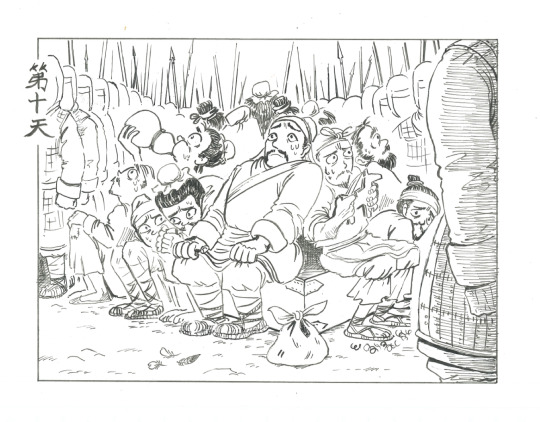
tenth day as a second century warlord on my way back to my loser liege lord’s city i realize i won’t be able to collect my men from my fake liege lord until i bring back my loser liege lord’s head. this would have been a great thing to think of before i got myself in this situation. i go back to my loser liege lord and ask him to rescue my men, and he tells me that if he could sack my fake liege lord’s camp he already would have. that doesn’t change the fact that my men are still trapped. they’re prisoners, even. i go back to my room to sulk
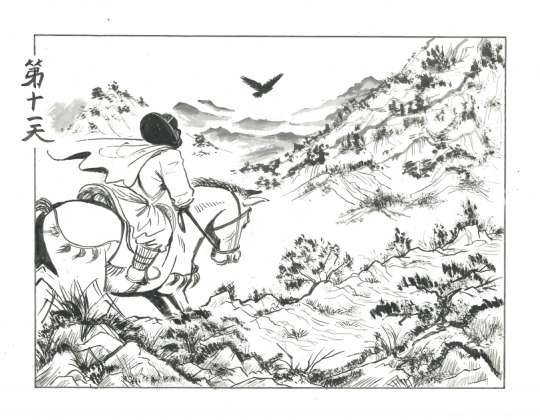
eleventh day as a second century warlord i find a little caged pigeon in the rafters of my loser liege lord’s room and deduce it belonged to the assassin. without asking permission or telling my loser liege lord goodbye i let the pigeon loose and follow it north. don’t ask what i was doing in my loser liege lord’s room. it’s not important
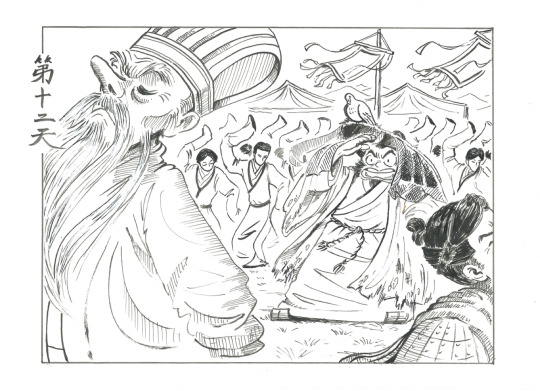
twelfth day as a second century warlord i disguise myself as a wizard and enter the camp of the coalition leader the pigeon led me to. in the middle of my little sleight of hand performance i make eye contact with the coalition leader’s second-in-command. IT’S THE WIZARD THAT STOLE MY LOSER LIEGE LORD’S WIFE. after the banquet i corner the fake wizard and ask him what the fuck is going on and he just says “wouldn’t you like to know” and leaves. i don’t know what to say to that so i just let him go

thirteenth day as a second century warlord i’m honestly so sick of not knowing what’s going on, so i adjust my wizard costume to passably disguise myself as a woman and break into the women’s area of the camp, where sure enough my loser liege lord’s wife is. i ask her what she’s doing here and she tells me the fake wizard overheard her singing a poem she overheard on the street, not knowing it contains the coalition leader’s formation’s weaknesses. the fake wizard kidnapped her and assigned an assassin to kill her husband before they figured out the poem’s significance. she shares the first couplet with me but i’m discovered and thrown out before she can share any more. she doesn’t need to. through a bizarre coincidence of homophones, it’s the poop version of my misinformation nursery rhyme
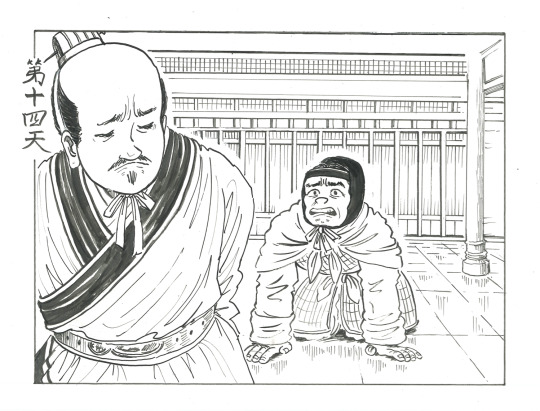
fourteenth day as a second century warlord i go back to my loser liege lord and tell him everything, urging him to join with my fake liege lord to attack the coalition leader according to the weaknesses in the nursery rhyme. he tells me frankly that he doesn’t trust me anymore. i ask him to execute me if that’s really true, because i can’t bear to live if i can’t protect him and i can’t protect my men. he agrees to attack the coalition leader

fifteenth day as a second century warlord. due to the information in the nursery rhyme, and thanks to my loser liege lord reminding me of the weather conditions multiple times while planning our battle strategy, our alliance carries the day. my loser liege lord gets his wife back. my men tell me that our fake liege lord actually treated them really well and they’d like to stay with him if i don’t mind. i do mind, now that neither the men i love nor the man i love have any use for me, but i don’t tell them that
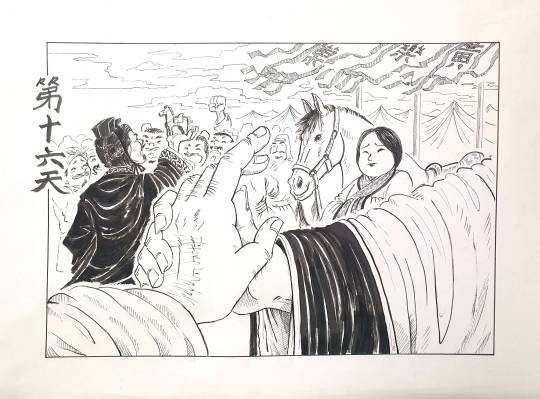
sixteenth day as a second century warlord i’m preparing to leave to i don’t know where, maybe to try to become a wizard for real, when my loser liege lord stops me and asks me where i’m going. he says he had hoped i would continue to work as his advisor. i was unaware i was his advisor in the first place. i agree, and he tells me he’s truly honored to have me in his service at last. he has known i am a rare and talented man with a strategic intelligence far above his ever since the day he witnessed me tying branches to my horses’ tails in six inches of mud, and could not for the life of him figure out why
The end.
Thanks for reading! Notes under the cut
CORRECTION#1: the warlord's courtesy name was incorrectly written as Yú zhī 餘知 [plentiful knowledge]. my dumbass did not realise zhī 知 [to know] is a GOD DAMN VERB. It should be zhì 智 [wisdom].
CORRECTION#2: the clothes from part one are from the WRONG DYNASTY!!! BY 1200 YEARS!!!! it's meant to be HAN not MING.
#9 Misreading the standards: Loser Liege's name is Yue, so I decided to go with Lè/Yuè 樂 [optimistic/music]. I made the Chad Liege's name Cháo 巢 [nest] which is pronounced identically to Cáo 曹, the infamous IRL warlord. Just like his IRL counterpart, he is the affable, lawful-evil boss who is kind to his employees. I went ALL OUT designing Lord Chad Chao's outfit. He's got so much drip the yangtze river is about to break its banks. Now THAT'S a main character!
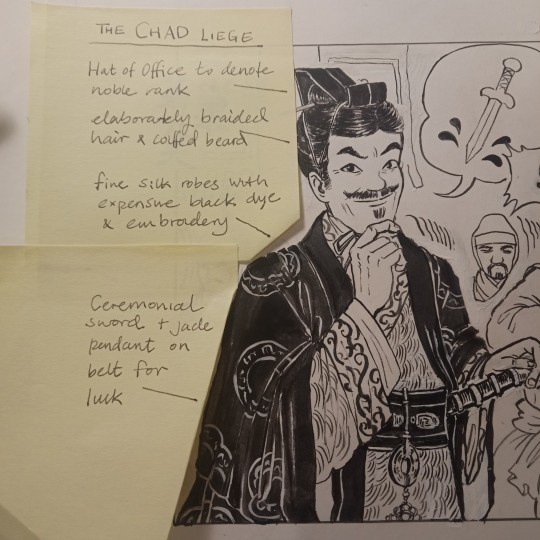

#10 Wardrobe Malfunction: the soldiers are now wearing clothes from the correct dynasty. i even gave them grass sandals! I really wanted to show how utterly outclassed they are, this is the difference between a peasant militia and a professional army. (They're in the exact same poses as part 1, except more terrified).
#11 mountain-water art: man i love doing traditional style backgrounds, the white space is very pleasing. Does it make sense to camp your coalition out in the mountains? No. Is it cool? Hella.
#12 you're a wizard, hairy: my favourite detail is the pigeon from day 11 sitting on the warlord's hat. I had to cut SO MUCH from this scene because there wasn't room. There was going to be musicians, jesters and strongmen. (Based of funerary figures)



I wanted to make it clear that the Coalition Liege is the richest guy of all, but he is all style and no substance. He's got an army of dancing girls and drunk officers. You get the feeling that his Chief Strategist aka Fake Wizard aka Zhuge Liang Knockoff, disproves.
#13 Hua Mulan: RIP the Warlord's beautiful beard ;n; He's wearing one of the dancing girl's outfits and I like to think the ladies helped him do his makeup too. I wanted to add a little character moment for the Wife and Warlord. They're holding hands which is not strictly proper, but I wanted to show the intensity of the emotions.
#14 the supplicant: I really like the framing here, I wanted both faces to be visible so we can see what they're thinking.
#15 enemy of my enemy: the Warlord is finally in command and flying his standard Huáng 黃 [yellow]. He is wearing a wu guan with two pheasant feathers, for a high ranking military official.
#16 the romantic subplot: the Warlord and his Loser are tenderly holding hands while the Wife and Noble Steed looks on with approval. I wanted the handholding to be slightly awkward and kinda spontaneous, like they were both aiming for a manly, platonic hand-clasp but veered wildly off-course into homoeroticism. In the background, an oblivious Lord Chad is showing off the little wooden horse one of his new soldiers gave him (that guy's been carving it since part 1, it's high time we acknowledged his hard work).
Want to learn more about the (mostly) true story that inspired this post? Check out Romance of the Three Kingdoms! TV show, the book and the movie Red Cliff,
#second century warlord#han dynasty#romance of the three kingdoms#history#thanks for reading guys i had a blast drawing this
956 notes
·
View notes
Text
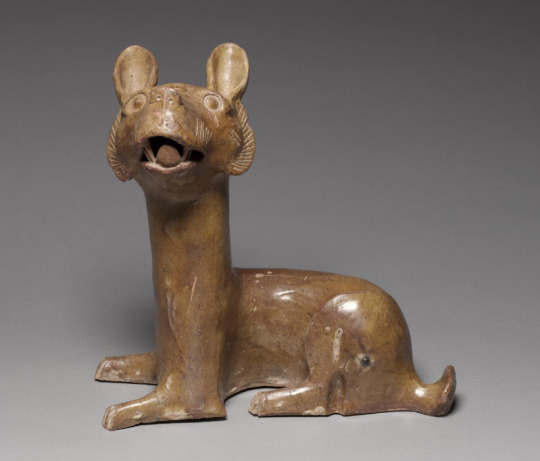
Earthenware dog, China, Eastern Han Dynasty 25-220 AD
from The Cleveland Museum of Art
538 notes
·
View notes
Text
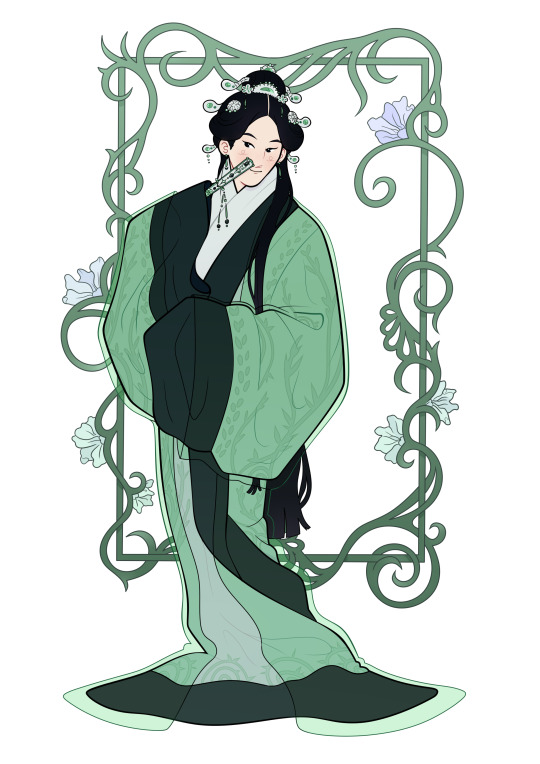
Notification: The peerless jade fairy of Cang Qiong's Mountain Sect is smiling! Looks like he's easily amused by his disciples' antics...!!! What a surprise!!! +300 Overwhelming Beauty Points!
Ok now for my silly little notes in fashion and other nonsense about this piece:
This is specifically Shen Yuan during the pre-abyss arc, mostly because I have a very, very different interpretation of him when he's already married to Binghe- Empress Shen is a whole other, much more decked out beast I will one day tackle.
His clothes are based on late Qin to early Han dynasty clothes for women, mostly because I can, and it seemed perfect for him; it's completely covered, and thus respectable and elegant! Nothing wrong to see here. It's also tight-er around the legs, which leaves things to the imagination...half of the mountain is definitely thinking about his long, slender, lily-white legs at any given time.
Is it technically crossdressing? Yeah, but it is a shitty Xia-Xia world, who's gonna stop me? Airplane? That guy would be on my side, actually.
The see-through outer robe is a flex, look at all that expensive fabric...just hanging off of him...a rich kid in one life a rich kid in all of them.
Binghe does his hair because he's terrible at it and can only do half-updo's or ponytails, he's too distracted by the mere thought of touching Shizun's hair to stop and think why Shen Qingqiu can't do it all of a sudden thankfully.
The hair, on a more serious note, is a bit more realistic to ancient-Chinese hair than an actual half-updo. Though it is more similar to late Han or Tang dynasties hairstyles than anything. Again, shitty Xia-Xia, don't play with me.
There's a little turtle in his fan because I think he'd be like awn that's so cute and either Liu Qingge or Yue QingYuan would be immediately like. I'll buy it!!! He acquires many-a-thing by simply looking cute and staring at it until one of them gets it for him I'm sure.
#art#digital art#artists on tumblr#my art#fanart#svsss#scum villain fanart#scum villain#scum villian self saving system#shen qingqiu#shen yuan#peerless cucumber#cucumber bro#han dynasty#chinese hanfu#hanfu accessories
1K notes
·
View notes
Text
April 14, Xi'an, China, Shaanxi History Museum, Qin and Han Dynasties Branch (Part 3 – Innovations and Philosophies):
(Edit: sorry this post came out so late, I got hit by the truck named life and had to get some rest, and this post in itself took some effort to research. But anyway it's finally up, please enjoy!)
A little background first, because this naming might lead to some confusions.....when you see location adjectives like "eastern", "western", "northern", "southern" added to the front of Zhou dynasty, Han dynasty, Song dynasty, and Jin/晋 dynasty, it just means the location of the capital city has changed. For example Han dynasty had its capital at Chang'an (Xi'an today) in the beginning, but after the very brief but not officially recognized "Xin dynasty" (9 - 23 AD; not officially recognized in traditional Chinese historiography, it's usually seen as a part of Han dynasty), Luoyang became the new capital. Because Chang'an is geographically to the west of Luoyang, the Han dynasty pre-Xin is called Western Han dynasty (202 BC - 8 AD), and the Han dynasty post-Xin is called Eastern Han dynasty (25 - 220 AD). As you can see here, in these cases this sort of adjective is simply used to indicate different time periods in the same dynasty.
Model of a dragonbone water lift/龙骨水车, Eastern Han dynasty. This is mainly used to push water up to higher elevations for the purpose of irrigation:
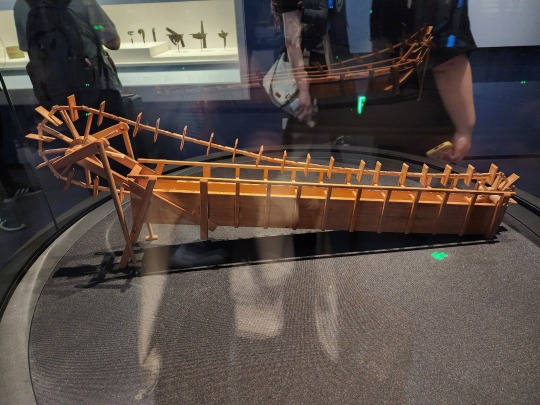
Model of a water-powered bellows/冶铁水排, Eastern Han dynasty. Just as the name implies, as flowing water pushes the water wheel around, the parts connected to the axle will pull and push on the bellows alternately, delivering more air to the furnace for the purpose of casting iron.

The Nine Chapters on the Mathematical Art/《九章算术》, Fangcheng/方程 chapter. It’s a compilation of the work of many scholars from 10 th century BC until 2 nd century AD, and while the earliest authors are unknown, it has been edited and supplemented by known scholars during Western Han dynasty (also when the final version of this book was compiled), then commented on by scholars during Three Kingdoms period (Kingdom of Wei) and Tang dynasty. The final version contains 246 example problems and solutions that focus on practical applications, for example measuring land, surveying land, construction, trading, and distributing taxes. This focus on practicality is because it has been used as a textbook to train civil servants. Note that during Han dynasty, fangcheng means the method of solving systems of linear equations; today, fangcheng simply means equation. For anyone who wants to know a little more about this book and math in ancient China, here’s an article about it. (link goes to pdf)
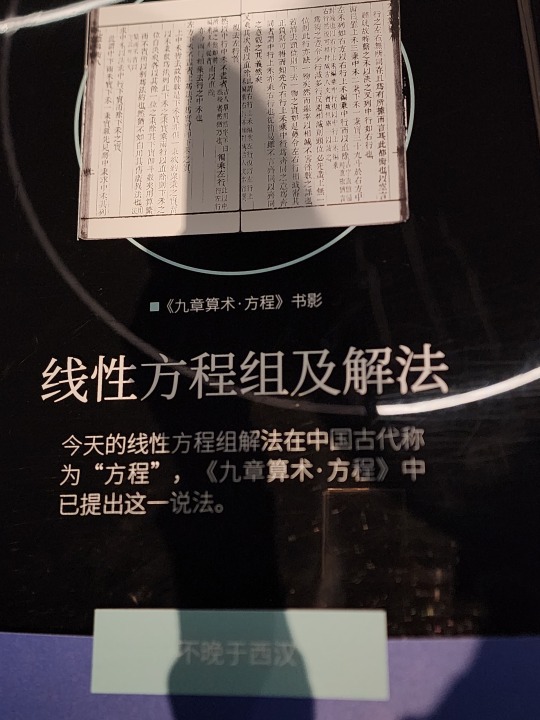
Diagram of a circle in a right triangle (called “勾股容圆” in Chinese), from the book Ceyuan Haijing/《测圆海镜》 by Yuan-era mathematician Li Ye/李冶 (his name was originally Li Zhi/李治) in 1248. Note that Pythagorean Theorem was known by the name Gougu Theorem/勾股定理 in ancient China, where gou/勾 and gu/股 mean the shorter and longer legs of the right triangle respectively, and the hypotenuse is named xian/弦 (unlike what the above linked article suggests, this naming has more to do with the ancient Chinese percussion instrument qing/磬, which is shaped similar to a right triangle). Gougu Theorem was recorded in the ancient Chinese mathematical work Zhoubi Suanjing/《周髀算经》, and the name Gougu Theorem is still used in China today.

Diagram of the proof for Gougu Theorem in Zhoubi Suanjing. The sentence on the left translates to "gou (shorter leg) squared and gu (longer leg) squared makes up xian (hypotenuse) squared", which is basically the equation a² + b² = c². Note that the character for "squared" here (mi/幂) means "power" today.

This is a diagram of Zhang Heng’s seismoscope, called houfeng didong yi/候风地动仪 (lit. “instrument that measures the winds and the movements of the earth”). It was invented during Eastern Han dynasty, but no artifact of houfeng didong yi has been discovered yet, this is presumably due to constant wars at the end of Eastern Han dynasty. All models and diagrams that exist right now are what historians and seismologists think it should look like based on descriptions from Eastern Han dynasty. This diagram is based on the most popular model by Wang Zhenduo that has an inverted column at the center, but this model has been widely criticized for its ability to actually detect earthquakes. A newer model that came out in 2005 with a swinging column pendulum in the center has shown the ability to detect earthquakes, but has yet to demonstrate ability to reliably detect the direction where the waves originate, and is also inconsistent with the descriptions recorded in ancient texts. What houfeng didong yi really looks like and how it really works remains a mystery.
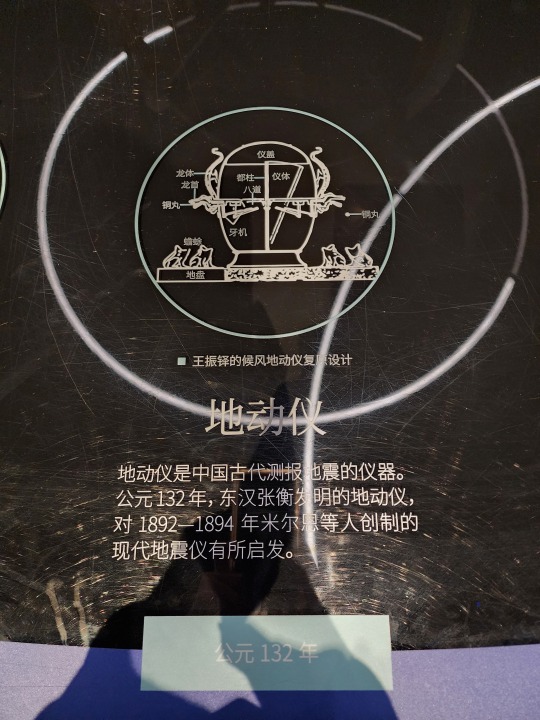
Xin dynasty bronze calipers, the earliest sliding caliper found as of now (not the earliest caliper btw). This diagram is the line drawing of the actual artifact (right).


Ancient Chinese "Jacquard" loom (called 提花机 or simply 花机 in Chinese, lit. "raise pattern machine"), which first appeared no later than 1st century BC. The illustration here is from the Ming-era (1368 - 1644) encyclopedia Tiangong Kaiwu/《天工开物》. Basically it's a giant loom operated by two people, the person below is the weaver, and the person sitting atop is the one who controls which warp threads should be lifted at what time (all already determined at the designing stage before any weaving begins), which creates patterns woven into the fabric. Here is a video that briefly shows how this type of loom works (start from around 1:00). For Hanfu lovers, this is how zhuanghua/妆花 fabric used to be woven, and how traditional silk fabrics like yunjin/云锦 continue to be woven. Because it is so labor intensive, real jacquard silk brocade woven this way are extremely expensive, so the vast majority of zhuanghua hanfu on the market are made from machine woven synthetic materials.

Chinese purple is a synthetic pigment with the chemical formula BaCuSi2O6. There's also a Chinese blue pigment. If anyone is interested in the chemistry of these two compounds, here's a paper on the topic. (link goes to pdf)

A list of common colors used in Qin and Han dynasties and the pigments involved. White pigment comes from chalk, lead compounds, and powdered sea shells; green pigment comes from malachite mineral; blue pigment usually comes from azurite mineral; black comes from pine soot and graphite; red comes from cinnabar; ochre comes from hematite; and yellow comes from realgar and orpiment minerals.

Also here are names of different colors and shades during Han dynasty. It's worth noting that qing/青 can mean green (ex: 青草, "green grass"), blue (ex: 青天, "blue sky"), any shade between green and blue, or even black (ex: 青丝, "black hair") in ancient Chinese depending on the context. Today 青 can mean green, blue, and everything in between.

Western Han-era bronze lamp shaped like a goose holding a fish in its beak. This lamp is interesting as the whole thing is hollow, so the smoke from the fire in the lamp (the fish shaped part) will go up into the neck of the goose, then go down into the body of the goose where there's water to catch the smoke, this way the smoke will not be released to the surrounding environment. There are also other lamps from around the same time designed like this, for example the famous gilt bronze lamp that's shaped like a kneeling person holding a lamp.


Part of a Qin-era (?) clay drainage pipe system:
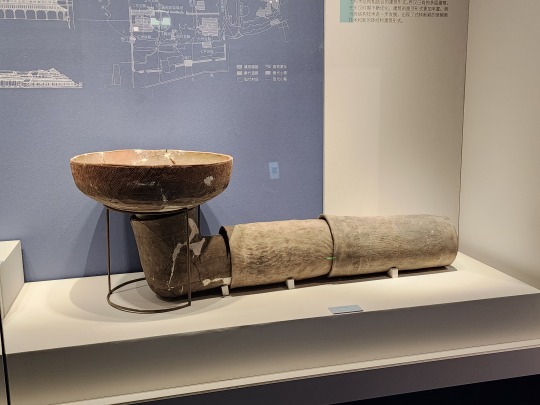
A list of canals that was dug during Warring States period, Qin dynasty, and pre-Emperor Wu of Han Han dynasty (475 - 141 BC). Their purposes vary from transportation to irrigation. The name of the first canal on the list, Hong Gou/鸿沟, has already become a word in Chinese language, a metaphor for a clear separation that cannot be crossed (ex: 不可逾越的鸿沟, meaning "a gulf that cannot be crossed").
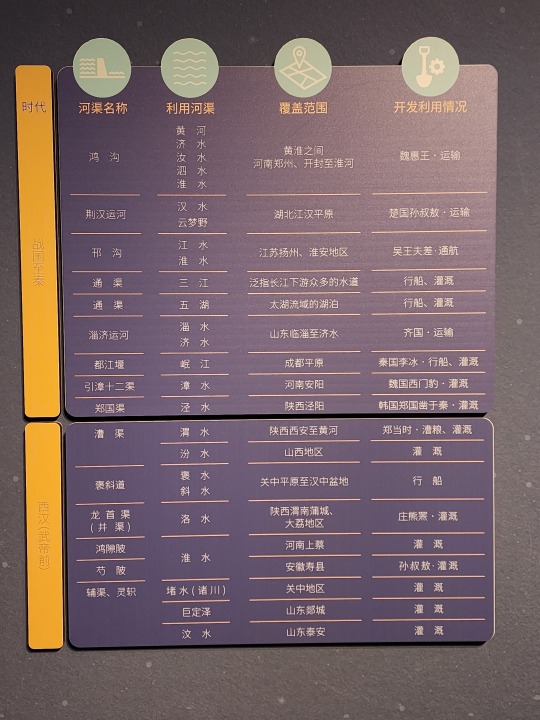
Han-era wooden boat. This boat is special in that its construction has clear inspirations from the ancient Romans, another indication of the amount of information exchange that took place along the Silk Road:

A model that shows how the Great Wall was constructed in Qin dynasty. Laborers would use bamboo to construct a scaffold (bamboo scaffolding is still used in construction today btw, though it's being gradually phased out) so people and materials (stone bricks and dirt) can get up onto the wall. Then the dirt in the middle of the wall would be compressed into rammed earth, called hangtu/夯土. A layer of stone bricks may be added to the outside of the hangtu wall to protect it from the elements. This was also the method of construction for many city walls in ancient China.

A list of the schools of thought that existed during Warring States period, their most influential figures, their scholars, and their most famous works. These include Confucianism (called Ru Jia/儒家 in Chinese; usually the suffix "家" at the end denotes a school of thought, not a religion; the suffix "教" is that one that denotes a religion), Daoism/道家, Legalism (Fa Jia/法家), Mohism/墨家, etc.

The "Five Classics" (五经) in the "Four Books and Five Classics" (四书五经) associated with the Confucian tradition, they are Shijing/《诗经》 (Classic of Poetry), Yijing/《易经》 (also known as I Ching), Shangshu/《尚书》 (Classic of History), Liji/《礼记》 (Book of Rites), and Chunqiu/《春秋》 (Spring and Autumn Annals). The "Four Books" (四书) are Daxue/《大学》 (Great Learning), Zhongyong/《中庸》 (Doctrine of the Mean), Lunyu/《论语》 (Analects), and Mengzi/《孟子》 (known as Mencius).

And finally the souvenir shop! Here's a Chinese chess (xiangqi/象棋) set where the pieces are fashioned like Western chess, in that they actually look like the things they are supposed to represent, compared to traditional Chinese chess pieces where each one is just a round wooden piece with the Chinese character for the piece on top:
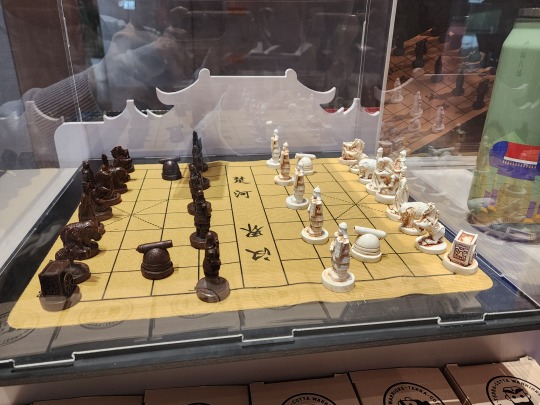
A blind box set of small figurines that are supposed to mimic Shang and Zhou era animal-shaped bronze vessels. Fun fact, in Shang dynasty people revered owls, and there was a female general named Fu Hao/妇好 who was buried with an owl-shaped bronze vessel, so that's why this set has three different owls (top left, top right, and middle). I got one of these owls (I love birds so yay!)


And that concludes the museums I visited while in Xi'an!
#2024 china#xi'an#china#shaanxi history museum qin and han dynasties branch#chinese history#chinese culture#chinese language#qin dynasty#han dynasty#warring states period#chinese philosophy#ancient technology#math history#history#culture#language
90 notes
·
View notes
Text

Day 4: Ban Zhao!
Ban Zhao was born into a noted scholarly family during China’s Eastern Han Dynasty, in the first century AD. Her father, Ban Biao, was an official and historian, and her great-aunt, a consort to Emperor Cheng of Han, had been a famous poet. Ban Zhao was married in her teens, and she and her husband had at least one son, but she was widowed soon after. She remained close with her natal family, helping her father and eldest brother compose the Book of Han, a history of the first half of the dynasty.
It was a turbulent time at the Han court. In 88 AD, a child Emperor ascended the throne, with his mother as regent; she, in turn, was overthrown in a coup d’etat. Ban Zhao’s brother, a supporter of the Empress Dowager, was imprisoned; his death soon after left the Book of Han unfinished and the family in a precarious place.
Ban Zhao took over. She completed the hundred-volume manuscript over the next two decades, while also serving as a tutor and librarian at court. Among her students was the consort and future empress Deng Sui, who after her husband’s death would go on to rule the empire as regent for successive child emperors.
In addition to the Book of Han, Ban Zhao’s surviving works include the Lessons for Women, a Confucian guide to female education and conduct, and a travelogue, Dong Zheng Fu, written when she moved with her son to his posting in modern-day Henan. She died a few years later; in an unusual honor for a commoner, the Empress herself went into official mourning.
#ban zhao#chinese history#han dynasty#history#hanfu#awesome ladies of history#october 2024#my art#colored pencil
36 notes
·
View notes